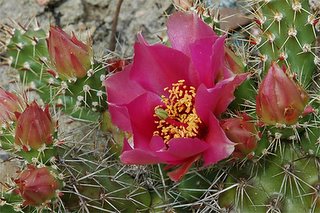My Rhodiola rosea plants are coming out of winter in great shape. A couple of years ago I collected a handful of rhizomes from habitat in Greenland and now grow the plants in an unprotected bed along with my hardy cacti. The Rhodiola rosea plants originate from the hills above Hospitalsdalen (Hospital Valley), a place named after an American military hospital built in connection with the Bluie West One airfield during the 2nd World War. The hills are situated a few kilometers north east of Narsarsuaq and from the top you have a direct view of the Greenland Ice Sheet – I guess the location says it all regarding the plants cold tolerance ;-)
Rhodiola rosea (Narsarsuaq, Greenland)
I’m a bit curious as to whether I have both male and female plants; when I dug up the rhizomes I didn’t know the plants were dioecious, so even though they were flowering at the time I didn’t pay attention to their sex.
Allegedly Rhodiola rosea is categorized as an adaptogen with various health-promoting effects (like e.g. Panax ginseng), but I have no experience with these aspects of the plant.
My Opuntias are also breaking out of dormancy and beginning to set new growth, as illustrated by the pictures below.
Opuntia tortispina (DJF 1139; west Albuquerque, New Mexico)
Opuntia hystricina (DJF 1138; Bernalillo County, New Mexico)
Friday, April 20, 2007
Budding spring - Rhodiola and Opuntia
Thursday, April 12, 2007
A visit to the New York Botanical Garden
I spent my Easter vacation in NYC and of course had to visit the New York Botanical Garden while in the neighborhood. The Easter weather was extremely cold with temperatures just above freezing – the cacti in the outdoor bed were all dormant so they seemed better prepared for the cold spell than we were ;-)
The NYBG outdoor cactus bed seems to be established or rearranged recently as very few of the plants are large and well established, one of the exceptions being a sprawling Opuntia pusilla.
Opuntia pusilla
View of cactus bed
Some of the dormant plants displayed beautiful winter colors, especially the O. basilaris and O. polyacantha cultivars were dazzling in their different shades of purple.
Opuntia basilaris 'Art Combe'
Opuntia polyacantha 'Candy Cane'
The Escobaria vivipara plants are growing just next to the footpath. Fortunately they weren’t trampled – in their withered state they could easily be overlooked if one swerved from the path.
Escobaria vivipara
The bed contains several species of Echinocereus, all looking fine after the winter. Inspired by this I might try to grow both Escobaria and Echinocereus in my unprotected bed (after investigating the differences in temperature and precipitation between Denmark and New York more thoroughly).
Echinocereus fendleri
Echinocereus dasyacanthus
A post on the NYBG cactus house (part of the Enid A. Haupt Conservatory) can be found here.
Posted by
Winter Hardy Cacti
at
9:29 PM
0
comments
![]()
![]()
Labels: Botanical Gardens, Echinocereus, Escobaria, Opuntia, Winter


